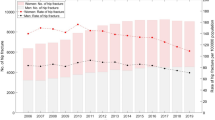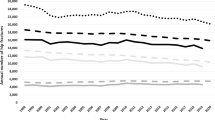Summary
To explore possible changes in proximal femur (hip) fracture incidence over time, an earlier study among Rochester, Minnesota residents for 1928–1977 was updated through 1982. Reanalysis of data demonstrated rising age-adjusted rates for men over this time. Crude rates rose for women as well, but age adjusted rates leveled off in the mid-1950s, as did overall rates, since the majority of hip fractures were in women. Secular trends were primarily due to changes in the incidence of initial hip fractures associated with moderate trauma, the sort usually attributed to osteoporosis. No differences were noted in trends for cervical vs. intertrochanteric femur fractures; and, excluding the low values for 1928–1942, no significant trends were noted for women within various age groups. Our results for women conflict with estimates from a number of other studies, but these differences may provide a basis for hypothesis development.
Similar content being viewed by others
References
Lindsay R, Dempster DW, Clemens T, Herrington BS, Wilt S (1985) Incidence, cost, and risk factors of fracture of the proximal femur in the USA. In: Christiansen C, Arnaud CD Nordin BEC, Parfitt AM, Peck WA, Riggs BL (eds) Osteoporosis. Copenhagen, pp 311–315
Cummings SR, Kelsey JL, Nevitt MC, O'Dowd K (1985) Epidemiology of osteoporosis and osteoporotic fractures. Epidemiologic Reviews 7:178–208
Baker MR (1980) An investigation into secular trends in the incidence of femoral neck fracture using hospital activity analysis. Public Health (London) 94:368–374
Lewis AF (1981) Fracture of neck of the femur: changing incidence. Br Med J 283:1217–1220
Wallace WA (1983) The increasing incidence of fractures of the proximal femur: an orthopaedic epidemic. Lancet 1:1413–1414
Swanson AJG, Murdoch G (1983) Fractured neck of femur: pattern of incidence and implications. Acta Orthop Scand 54:348–355
Nilsson BE, Obrant KJ (1978) Secular tendencies of the incidence of fracture of the upper end of the femur. Acta Orthop Scand 49:389–391
Zetterberg C, Andersson GBJ (1982) Fractures of the proximal end of the femur in Göteborg, Sweden, 1940–1979. Acta Orthop Scand 53:419–426
Frandsen PA, Kruse T (1983) Hip fractures in the county of Funen, Denmark. Acta Orthop Scand 54:681–686
Evans JG, Prudham D, Wandless I (1979) A prospective study of fractured proximal femur: incidence and outcome. Public Health (London) 93:235–241
Jensen JS (1980) Incidence of hip fractures. Acta Orthop Scand 51:511–513
Engesaeter LB, Søreide O (1984) Incidence of hip fractures based on hospital admission rates. Acta Orthop Scand (Abstract) 55:707
Holbrook TL, Grazier K, Kelsey JL, Stauffer RN (1984) The frequency of occurrence, impact and cost of selected musculoskeletal conditions in the United States. American Academy of Orthopaedic Surgeons
Kurland LT, Molgaard CA (1981) The patient record in epidemiology Sci Am 245:54–63
Kurland LT, Elveback LR, Nobrega FT (1970) Population studies in Rochester and Olmsted County, Minnesota, 1900–1968. In: Kessler H, Levin ML (eds) The community as an epidemiologic laboratory: a casebook of community studies. Johns Hopkins Press, Baltimore, Maryland, pp 47–70
Schroeder DJ, Offord KP (1982) A SAS Macro which utilizes local and reference population counts appropriate for incidence, prevalence, and mortality rate calculations in Rochester and Olmsted County, Minnesota. Technical Report Series, No. 20, Section of Medical Research Statistics, Mayo Clinic, Rochester, Minnesota
Beyer Wh (ed) (1966) C.R.C. handbook of tables for probability and statistics. Chemical Rubber Company, Cleveland, pp 58–64
Armitage P (1955) Tests for linear trends in proportions and frequencies. Biometrics 11:375–386
Draper NR, Smith H (1966) Applied regression analysis. John Wiley and Sons, New York
Knowelden J, Buhr AJ, Dunbar O (1964) Incidence of fractures in persons over 35 years of age: a report to the M.R.C. working party on fractures in the elderly. Br J Prev Soc Med 18:130–141
Hoogendoorn D (1982) Mededelingen stichting medische registratie. Ned T Geneesk 126:963–968
Elabdien BSZ, Olerud S, Karlström G, Smedby B (1984) Rising incidence of hip fracture in Uppsala, 1965–1980. Acta Orthop Scand 55:284–289
Cave W, Nordin BEC (1972) International fracture survey first year report to the International Health Foundation, privately published
Evans JG (1985) Incidence of proximal femoral fracture (Letter) Lancet 1:925–926
Stewart IM (1958) Fracture of neck of femur: the rate risk and casualty planning. The Medical Officer 100:100
Boyce WJ, Vessey MP (1985) Rising incidence of fracture of the proximal femur. Lancet 1:150–151
Johnell O, Nilsson B, Obrant K, Sernbo I (1984) Age and sex patterns of hip fracture—changes in 30 years. Acta Orthop Scand 55:290–292
Lüthje P (1983) Fracture of the proximal femur in Finland in 1980. Ann Chir Gynaecol 72:282–286
Melton LJ, Ilstrup DM, Riggs BL, Beckenbaugh RD (1982) Fifty-year trend in hip fracture incidence. Clin Orthop 162:144–149
Eddy TP (1972) Deaths from domestic falls and fractures. Br J Prev Soc Med 26:173–179
Falch J, Ilebekk A (1978) Fractures of the proximal end of the femur: prevalence and incidence on Oslo, 1950–1975. Tidsskr Nor Laegeforen 98:738–739
Hedlund R, Ahlbom A, Lindgren U (1985) Hip fracture incidence in Stockholm 1972–1981. Acta Orthop Scand 57: 30–34
Buhr AJ, Cooke AM (1959) Fracture patterns. Lancet 1:531–536
Evans JG (1979) Fractured proximal femur in Newcastle upon Tyne. Age Ageing 8:16–24
Alffram P-A (1964) An epidemiologic study of cervical and trochanteric fractures of the femur in an urban population: analysis of 1,664 cases with special reference to etiologic factors. Acta Orthop Scand (Suppl) 65:9–109
Waris P, Kankaanpää, Karaharju E, Michelsson J-E, Ryöppy S, Snellman O (1979) Fractures of the proximal femur in Finland in 1975. Ann Chir Gynaecol (Suppl) 68: 86–89
Rees JL (1982) Accuracy of hospital activity analysis data in estimating the incidence of proximal femoral fracture. Br Med J 284:1856–1857
Williams BT (1977) Femoral neck fractures. Br Med J 1:171–172
Baldwin JA (1982) Fracture of neck of the femur. (Letter) Br Med J 284:271
Melton LJ III, Stauffer RN, Chao EYS, Ilstrup DM (1982) Rates of total hip arthroplasty: a population-based study. N Engl J Med 307:1242–1245
Melton LJ, Stauffer RN, Chao EYS, Ilstrup DM (1983) Rates of total hip arthroplasty: a population-based study (Letter). N Engl J Med 308:726–727
Falch JA, Ilebekk A, Slungaard U (1985) Epidemiology of hip fractures in Norway. Acta Orthop Scand 56:12–16
Burton JL, Ensell FJ, Leach JF, Hall KA (1975) Atmospheric ozone and femoral fractures. Lancet 1:795–796
Leach JF, Beadle PC, Pingstone AR (1978) Effect of ozone variation on disease in Great Britain. II. Femoral neck fracture. Aviat, Space, Environ Med 49:1014–1018
Stott S, Gray DH (1980) The incidence of femoral neck fractures in New Zealand. N Zealand Med J 91:6–9
Lawrence JS (ed) (1977) Diseases of bone. In: Rheumatism populations. William Heinemann Medical Books Ltd, London, pp 398–434
Lindsay R, Hart DM, Forrest C, Baird C (1980) Prevention of spinal osteoporosis in oophorectomised women. Lancet 2:1151–1154
Ettinger B, Genant HK, Cann CE (1985) Long-term estrogen replacement therapy prevents bone loss and fractures. Ann Intern Med 102:319–324
Hutchinson TA, Polansky SM, Feinstein AR (1979) Postmenopausal oestrogens protect against fractures of hip and distal radius: a case-control study. Lancet 2:705–709
Weiss NS, Ure CL, Ballard JH, Williams AR, Daling JR (1980) Decreased risk of fractures of the hip and lower forearm with postmenopausal use of estrogen. N Engl J Med 303:1195–1198
Paganini-Hill A, Ross RK, Gerkins VR, Henderson BE, Arthur M, Mack TM (1981) Menopausal estrogen therapy and hip fractures. Ann Intern Med 95:28–31
Kreiger N, Kelsey JL, Holford TR, O'Connor T (1982) An epidemiologic study of hip fracture in postmenopausal women. Am J Epidemiol 116:141–148
Annegers JF, Strom H, Decker DG, Dockerty MB, O'Fallon WM (1979) Ovarian cancer: incidence and case-control study. Cancer 43:723–729
McDonald TW, Annegers JF, O'Fallon WM, Dockerty MB, Malkasian GD, Kurland LT (1977) Exogenous estrogen and endometrial carcinoma: case-control and incidence study. Am J Obstet Gynecol 127:572–580
Grodin JM, Siiteri PK, MacDonald PC (1973) Source of estrogen production in postmenopausal women. J Clin Endocrinol Metab 36:207–214
Bates GW, Whitworth NS (1982) Effects of obesity on sex steroid metabolism. J Chron Dis 35:893–896
Abraham S, Johnson CL, Najjar MF (1979) Weight by height and age for adults 18–74 years: United States, 1971–74. Data from the National Health Survey, Series 11, Number 208, DHEW Publication No. (PHS) 79-1656, Hyattsville, Maryland
Williams AR, Weiss NS, Ure CL, Ballard J, Daling JR (1982) Effect of weight, smoking, and estrogen use on the risk of hip and forearm fractures in postmenopausal women. Obstet Gynecol 60:695–699
Baron JA (1984) Smoking and estrogen-related disease. Am J Epidemiol 119:9–22
Harris JE (1979) Cigarette smoking in the United States, 1950–1978. In Smoking and health, a report of the surgeon general. Washington, DC, DHEW Publication No. (PHS) 79-50066, A-3–A-29
Beard CM, Annegers JF, Woolner LB, Kurland LT (1985) Bronchogenic carcinoma in Olmsted County, 1935–1979. Cancer 55:2026–2030
Matković V, Kostial K, Šimonović I, Buzina R, Brodarec A, Nordin BEC (1979) Bone status and fracture rates in two regions of Yugoslavia. Am J Clin Nutr 32:540–549
Wong PC (1964) Femoral neck fractures among the major racial groups in Singapore. Incidence patterns compared with non-Asian communities. No. II. Singapore Med J 5:150–157
Chalmers J, Ho KC (1970) Geographical varitions in senile osteoporosis: the association with physical activity. J Bone Joint Surg 52-B:667–675
Solomon L (1968) Osteoporosis and fracture of the femoral neck in the South African Bantu. J Bone Joint Surg 50-B:2–13
Aaron JE, Gallagher JC, Nordin BEC (1974) Seasonal variation of histological osteomalacia in femoral-neck fractures. Lancet 2:84–85
Parfitt AM, Duncan H (1982) Metabolic bone disease affecting the spine. Chapter 13. In: Rothman RH, Simeone FA (eds) The spine. WB Saunders Company, Philadelphia, pp 775–905
Riggs BL (1984) Vitamin D and involutional osteoporosis. In: Kumar R (ed) Vitamin D: basic and clinical aspects. Martinus Nijhoff Publishing, Boston, pp 560–577
Evans JG (1982) Epidemiology of proximal femoral fractures. In: Recent advances in geriatric medicine, Vol. 2, Churchill-Livingstone, London, pp 201–214
Melton LJ III, Riggs BL (1983) Epidemiology of age-related fractures. In: Avioli LV (ed) The osteoporotic syndrome. Grune and Stratton, New York, pp 45–72
Melton LJ, Wahner HW, Richelson LS, O'Fallon WM, Riggs BL (1986) Osteoporosis and the risk of hip fracture. Am J Epidemiol 124:254–261
Doyle F, Brown J, Lachance C (1970) Relation between bone mass and muscle weight. Lancet 1:391–393
Dalén N, Olsson KE (1974) Bone mineral content and physical activity. Acta Orthop Scand 45:170–174
Mazess RB, Whedon GD (1983) Immobilization and bone. Calcif Tissue Int 35:265–267
Cowan RS (1987) Less work for mother?. The American Heritage of Invention and Technology 2:57–63
Macdonald JB (1985) The role of drugs in falls in the elderly. Clin Geriatr Med 1:621–636
Ray WA, Griffin MR, Schaffner W, Baugh DK, Melton LJ III (1987) Psychotropic drug use and the risk of hip fracture. N Engl J Med 316:363–369
Rodstein M (1964) Accidents among the aged: incidence, causes and prevention. J Chron Dis 17:515–526
Ashley MJ, Gryfe CI, Amies A (1977) A longitudinal study of falls in an elderly population. II. Some circumstances of falling. Age Ageing 6:211–220
Author information
Authors and Affiliations
Rights and permissions
About this article
Cite this article
Joseph Melton, J., O'Fallon, W.M. & Riggs, B.L. Secular trends in the incidence of hip fractures. Calcif Tissue Int 41, 57–64 (1987). https://doi.org/10.1007/BF02555245
Received:
Revised:
Issue Date:
DOI: https://doi.org/10.1007/BF02555245




